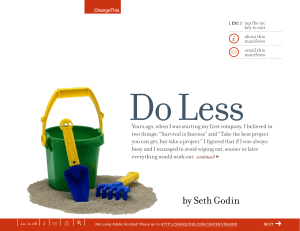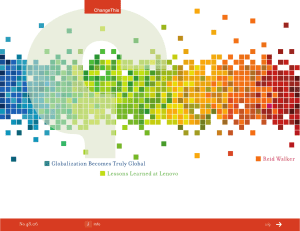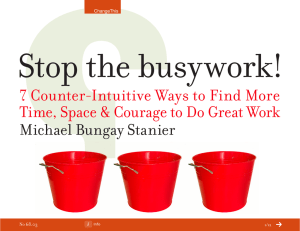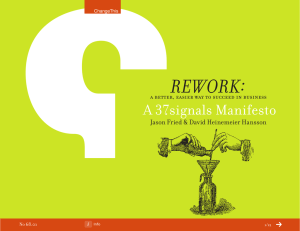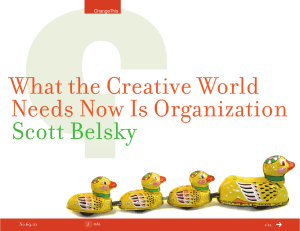Collaborative Organization Jacob
advertisement
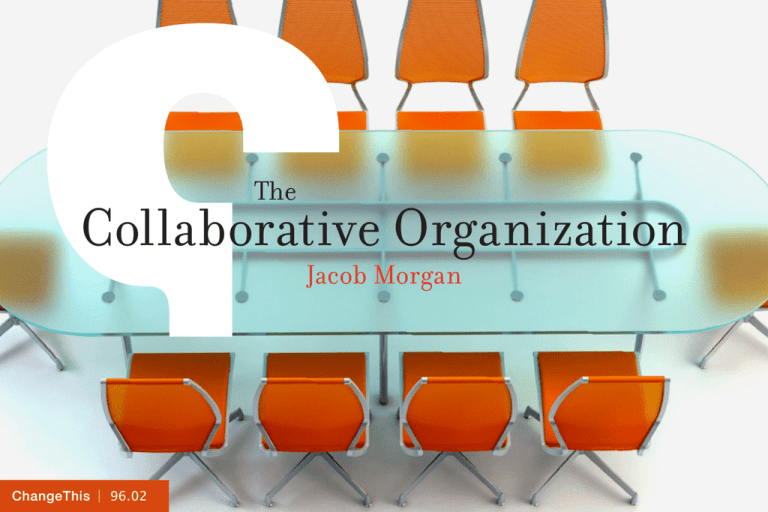
The Collaborative Organization Jacob Morgan ChangeThis | 96.02 Many thousands of years ago, cavemen communicated by hitting sticks against objects, using hand signals, and grunting—and thus collaboration was born. Collaboration is not new and the concept behind collaboration is actually quite simple— two or more people working together to create something or to achieve a goal—but the impact is profound. Even in this simple scenario, a lot is required. First we need to find someone to collaborate with, and that person needs to be relevant to what it is we are doing. Then we need to communicate to that person that we could use their help. That person needs to acknowledge the communication and offer their help. Then a sufficient amount of trust and mutual benefit needs to exist in order for you and the other person to proceed in actually collaborating together. Assuming that’s the case, the two of you need to maintain constant communication during the course of the collaboration and make sure that both of you have access to the right information and resources to collaborate. Once the collaboration is complete, both parties should be recognized for the completed creation or project and be rewarded appropriately. In a modern organization, this typically also means having their names attached to the finished collaboration, getting feedback (and recognition) on it and, if necessary, revising and adapting the finished product. ChangeThis | 96.02 You can see that even in the simple example above collaboration has a lot of moving parts. Now imagine what this looks like for an organization with hundreds, tens of thousands, or hundreds of thousands of employees. What would that look like? How would it scale across the organization? What is the impact of this collaboration and how can we make it work? We spend a lot of time discussing and coming up with ideas for how we can get more productivity out of our employees and get them to innovate faster and better. This sells collaboration short of its true value. Collaboration goes far beyond that. I believe that collaborative organizations can make the world a better place. A bold statement I know, but one that I believe in quite passionately. Organizations have always spent time and money on implementing various internal systems such as CRM, ERP, HR, and finance and bookkeeping tools. Why are collaborative and social tools for employees within organizations different? After all, those tools can be used across those many systems. And I believe that, for the first time in history, organizations are able to deploy technologies and strategies that not only impact the lives of employees in the workplace, but also outside of the workplace—both for the better. Think about how much time we spend at work and in fact how much time we spend thinking about work when we aren’t even there. Did you know that, in the U.S. alone, organizations spend around 400 billion dollars on stress related employee issues? ChangeThis | 96.02 It’s unfortunate that so many people talk about their jobs in terms of how they can get work to “suck less.” Why does work need to suck at all? Seriously, why should the one thing that takes up so much time in our lives have to suck? How can we as people live happy and fulfilled lives if this is the case? Consider some of the following: • Lost productivity of disengaged employees costs the economy $370 billion annually. (Gallup) • 45% of engaged employees say they get a great deal of their life happiness from work, against 8% of the disengaged. (Gallup) • Fewer than 1 in 3 employees worldwide (31%) are engaged. Nearly 1 in 5 (17%) are actually disengaged. (Blessing White) • Research conducted by Time magazine in 2010 indicated that less than half of American workers (45%) are satisfied with their jobs. This is the lowest percentage since 1987. • 72% of US workers are not engaged in their work—defined as essentially sleepwalking throughout their day. (Gallup) • Those companies with a highly engaged workforce improved operating income by 19.2% over a period of 12 months, whilst those companies with low engagement scores saw operating income decline by 32.7% over the same period. (Towers Watson) ChangeThis | 96.02 We have all heard about how social media tools are changing the ways in which organizations communicate and collaborate with customers. It is important to use these tools to engage customers, but organizations need to change and evolve from the inside out, and that means starting with employees. The challenges within many organizations today aren’t new: • too much time spent in email • too much time spent searching for information • poor communication across departments and geographies • not engaged or passionate about the work that one is doing • lack of growth and ability to keep learning • inability to share or transfer knowledge that can benefit others • inability to form communities of interest and/or passion • content duplication • difficulty in finding information and keeping that information up to date • finding subject matter experts ChangeThis | 96.02 The use of these new social and collaborative technologies and strategies are being deployed and implemented to solve many of these problems within the enterprise today. But, collaboration doesn’t just benefit employees while they are at work, it also benefits them in their personal lives as well. Imagine being able to connect and engage employees so that their lives at work are easier. What do you think would happen to employees if we improved their work life? I believe that collaboration at work will improve the lives of employees outside of work. Employees will feel less stressed about the work they do, will be more passionate about their work, will understand how their contributions impact the organization as a whole, will be able to connect with their coworkers around topics of interest and passion, and will be able to work from multiple physical locations. Yes, all these things mean that employees will have more time to spend with their family and less time stressing about and worrying about what’s going on at work. While this message is great and powerful, I realize that it was not enough for leaders and executives. No, leaders and executives need more than that. The only way to make an idea an action is to put business value, strategy, and tactics behind it. But what is a Collaborative Organization? The ideal is for an organization that is able to collaborate and share with employees, partners, and customers. We hear a lot about listening to our customers and the Voice of the Customer, but what about the Voice of the Employee? Why are ChangeThis | 96.02 we spending so much time listening to our customers. Should we not also be listening to, empowering, and supporting our employees? Employees make the company run, and we need to spend more time and attention on listening to and building them up. While establishing a culture that builds up employees is crucial, emergent and evolving technologies also play an important role in being able to facilitate collaboration—to connect and engage employees within the workplace. This is why it’s important to make sure that the right tools are selected and deployed. “ Collaboration doesn’t just benefit employees while they are at work, it also benefits them in their personal lives as well. Over the last five to seven years we have become much more comfortable sharing information publicly. Facebook allows us to share our hobbies and interests, Twitter lets us share our thoughts and ideas, Flickr gives us the power to share images, and platforms such as Foursquare allows users to share their physical locations. Yes, the world has become more public. In fact, it is becoming hard to distinguish between our personal and professional lives. The time we ChangeThis | 96.02 spend on our personal lives and the time we spend on our professional lives are blurring. We frequently see employees take their work home with them or get things done from the road. It seems that we are always “connected” to the digital world. Not that long ago we had to make an effort to get connected; now we have to make an effort to get disconnected. And aside from moving to a remote location in the wilderness or cutting off the power to our houses, we don’t have that many other options (even cutting off the power won’t prevent you from getting Wi-Fi at the café just around the corner.) This connectivity is virtually all we need to get our jobs done and manage many aspect of our lives, so long as we have the tools to do so. Organizations around the world have already started their journey towards empowering and connecting their employees. Here are a few examples: TELUS | One of Canada’s largest telecommunications company with almost 40,000 employees, TELUS has embarked on a journey to enable a sizable chunk of their workforce to work full-time and part time from home. Collaboration is embedded in new employee on-boarding and in executive education and training. This dramatic shift is improving communication across the organization, cutting costs, and improving the lives of employees at TELUS, who are reporting that they feel more engaged with the company and the work that they are doing. TELUS is continuing to make collaboration a core part of how they do business around the world. ChangeThis | 96.02 OCE | OCE, a global document management, printing, and systems services company with over 20,000 employees, has implemented several collaborative strategies and tools to break down the collaboration barriers within the organization. The culture at OCE was once one of fear, where employees were scared to share information with each other and admit that they needed help. While their journey is far from over, OCE has seen a dramatic impact in communication and innovation. One idea an employee suggested has been saving the company over 800,000 Euros annually and hundreds of thousands of Euros are being saved by not continuing to fund existing legacy intranet projects. OCE is still on their journey but are showing very positive signs that they are moving in the right direction. Elizabeth Glaser Pediatric AIDS Foundation | The Foundation is a non-profit organization dedicated to preventing pediatric HIV infection and eliminating pediatric AIDS through research, advocacy, and prevention, care, and treatment programs. The Foundation, currently working in 17 countries, was founded in 1988 and experienced significant growth in the last five years, with its employee base increasing from 200 employees in 2006 to over 1,500 in 2011 (and still growing). When it came to saving lives, The Foundation realized how crucial it was for employees to be able to share relevant information they might have and to find any information they might need to get their jobs done. The collective intelligence of The Foundation was incredible. The implementation of new tools and strategies helped support and sustain the growth of The Foundation while enabling and empowering employees to help each other across the world. ChangeThis | 96.02 These are just three of the many examples of organizations trying to become more collaborative. Organizations around the world are moving towards becoming more collaborative. The one thing I think organizations need to spend more addressing is not just the corporate benefits of collaboration, but the general life improvement benefits to employees. If you can provide these tools to your employees, you will not only get greater productivity out of them, you’ll be giving them a better quality of life and creating a more stable workforce—both in terms of their individual happiness and their commitment to your organization. I hope all of you reading this will walk away with three key things: 1. Collaboration itself is not new, but the changes in our culture and technology are new, and these changes are having dramatic impacts on the enterprise. 2. The benefits of collaboration aren’t just work related. Collaboration can positively impact the lives of employees and help make the world a better place. 3. Organizations are already moving down this path and the tools and resources exist to help. So, why are you still banging against the walls with sticks and using hand signals? It’s time to evolve. ChangeThis | 96.02 Info Buy the Book | Get more details or buy a copy of Collaborative Organization. About the Author | Jacob Morgan is the principal and cofounder of Chess Media Group, a management consultancy and strategic advisory firm that helps organizations understand how to use social and collaborative tools to solve business problems. Morgan has worked with organizations such as the U.S. Department of State, Siemens, Sprint, and Adobe. He also co-authored Twittfaced and runs the award-winning blog SocialBusinessAdvisor.com. He loves chess, racquetball, and traveling. ➔ Send this | Pass along a copy of this manifesto to others. ➔ Subscribe | Sign up for e-news to learn when our latest manifestos are available. This document was created on July 11, 2012 and is based on the best information available at that time. The copyright of this work belongs to the author, who is solely responsible for the content. This work is licensed under the Creative Commons Attribution-NonCommercial-NoDerivs License. To view a copy of this license, visit Creative Commons or send a letter to Creative Commons, 559 Nathan Abbott Way, Stanford, California 94305, USA. Cover image from Veer. You are given the unlimited right to print this manifesto and to distribute it electronically (via email, your website, or any other means). You can print out pages and put them in your favorite coffee shop’s windows or your doctor’s waiting room. You can transcribe the author’s words onto the sidewalk, or you can hand out copies to everyone you meet. You may not alter this manifesto in any way, though, and you may not charge for it. ChangeThis | 96.02 About ChangeThis ChangeThis is a vehicle, not a publisher. We make it easy for big ideas to spread. While the authors we work with are responsible for their own work, they don’t necessarily agree with everything available in ChangeThis format. But you knew that already. ChangeThis is supported by the love and tender care of 800-CEO-READ. Visit us at 800-CEO-READ or at our daily blog. Explore your knowledge further with KnowledgeBlocks, a new project from 800-CEO-READ that lets you turn what you know into knowledge you can use. ChangeThis | 96.02




